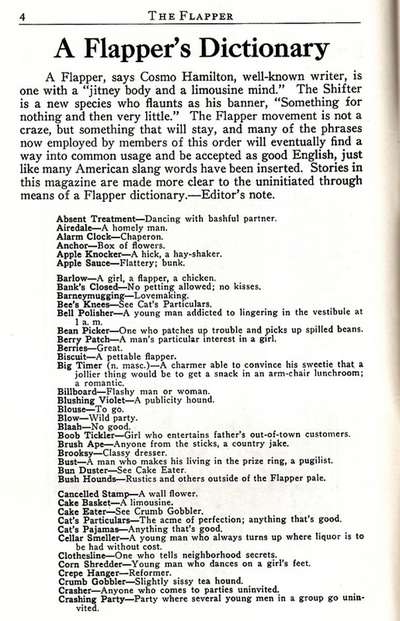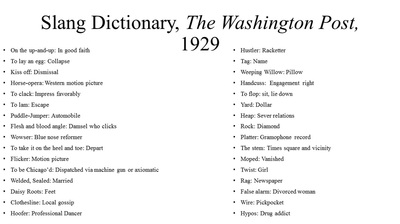Flappers were free spirited, rebels. These young women wanted to do anything that the older generations would not image them doing in their wildest dreams, or anything that they knew their elders would disapprove of. But their main goal above all else, was to just have fun while they were still young. For these three reasons, flappers rewrote the book of rules that young women lived by and changed their lifestyle. Due to this change, older generations thought flappers were risky and inappropriate which for the period they were. Little did flappers and their elders know, that these "wild young people" (The Case Against the Younger Generation #) were creating the modern women.
Language
|
Compared to the rest of the women around them, the things that flappers said were considered very crude. They were very opinionated women. Flappers were not afraid to share with others how they felt, nor were they shy when it came to discussing certain topics in public. Flappers frequently discussed some subjects, like sex, drinking, and partying, that had been considered taboo by their predecessors, The most shocking thing that these women did was use profanity. In the eyes of their elders it was neither "pure" or "ladylike" to use such vulgar language , at home or openly in public. Flappers also used the new slang of the 1920's like "Speed", "Sheba", "Swanky", and whatever else they or their male counterparts, came up with. To the right are some lists of words that flappers were known yo use. To see an even longer list from the April 29, 1929 edition of the Washington Post click here.
|
Overall Behavior
"To the girl to-day petting parties, cigaret-smoking, and in many cases drinking, are accepted as ordinary parts of existence.”
~Mr. R.M Budd, "The Case Against the Younger Generation", The Literary Digest June 24, 1922
~Mr. R.M Budd, "The Case Against the Younger Generation", The Literary Digest June 24, 1922
~"Male Activities"
During the 1920's flappers were known for "copying" the activities of men. After they were given the right to vote, many young women began to start drinking alcohol and smoke in public. Neither of these activities were considered lady-like, and were something that previous generations had been urged not to do when they were that age. They tried to ingrain this message into the heads of flappers, but it didn't work. Why? Because everyone else around them was doing it. Flappers did not understand why in the new urban culture that was developing in American it was okay for young men and their parents to smoke and drink, but it was not proper for them too.
~Petting
Flappers were known to let men take certain "liberties" with them that would appall the older generations. This was a major factor in the lower morals of the younger generation that has been refereed to through out the site. Flappers would allow men, that they were and were not dating, to kiss them and caress them in anyway they pleased.
~Dancing
Dancing became more risque in the 1920's, due to the changes in the values of the younger generation and the introduction of jazz to the rest of the country. Dancing was a big part of the life of flappers, because it was such a major component of the urban nightlife in big cities like Chicago and New York City.
During the 1920's flappers were known for "copying" the activities of men. After they were given the right to vote, many young women began to start drinking alcohol and smoke in public. Neither of these activities were considered lady-like, and were something that previous generations had been urged not to do when they were that age. They tried to ingrain this message into the heads of flappers, but it didn't work. Why? Because everyone else around them was doing it. Flappers did not understand why in the new urban culture that was developing in American it was okay for young men and their parents to smoke and drink, but it was not proper for them too.
~Petting
Flappers were known to let men take certain "liberties" with them that would appall the older generations. This was a major factor in the lower morals of the younger generation that has been refereed to through out the site. Flappers would allow men, that they were and were not dating, to kiss them and caress them in anyway they pleased.
~Dancing
Dancing became more risque in the 1920's, due to the changes in the values of the younger generation and the introduction of jazz to the rest of the country. Dancing was a big part of the life of flappers, because it was such a major component of the urban nightlife in big cities like Chicago and New York City.
“One outstanding reflection on the young set of to-day is the reckless pursuit of pleasure. Dancing has become far more popular- and far less respectable."
~William G. Harrison, "The Case Against the Younger Generation" The Literary Digest, May 19, 1922
~William G. Harrison, "The Case Against the Younger Generation" The Literary Digest, May 19, 1922
|
Fox Trot
Black Bottom
The Shimmy
Charleston
|
|





